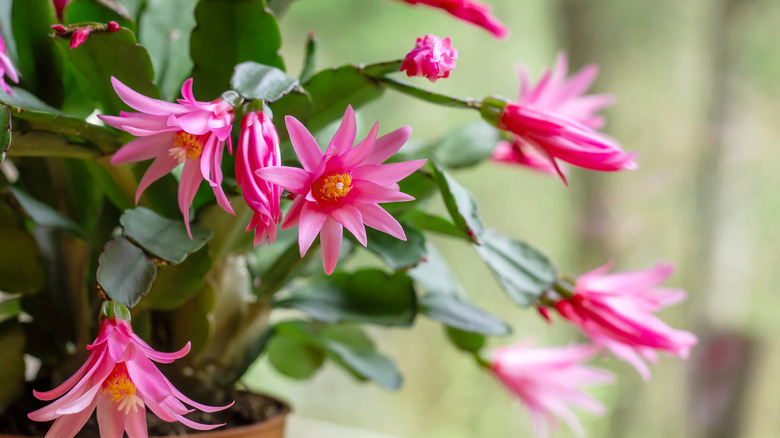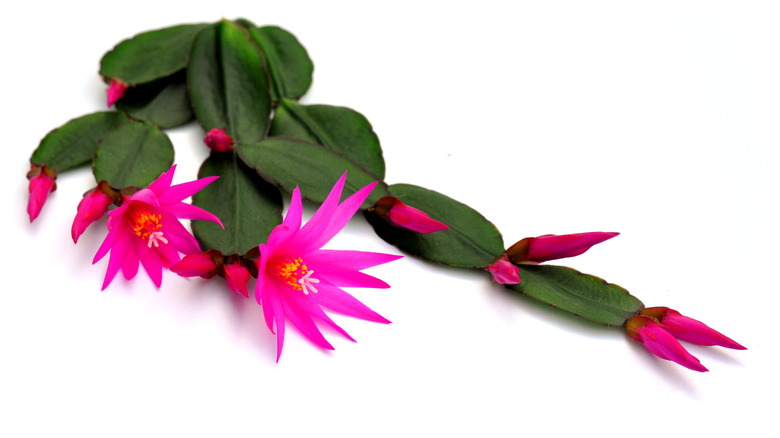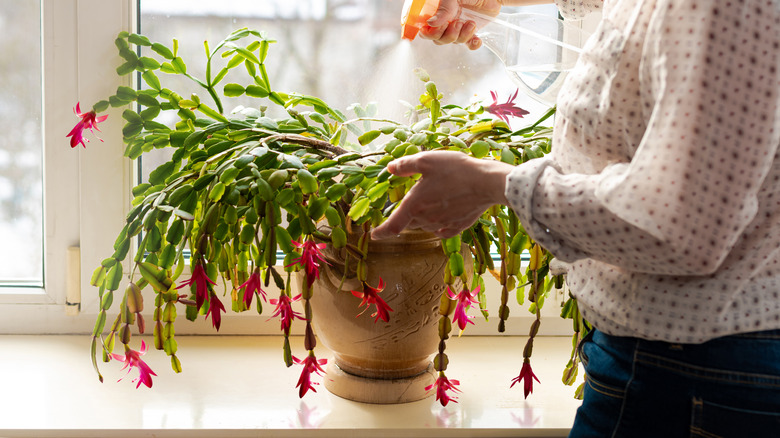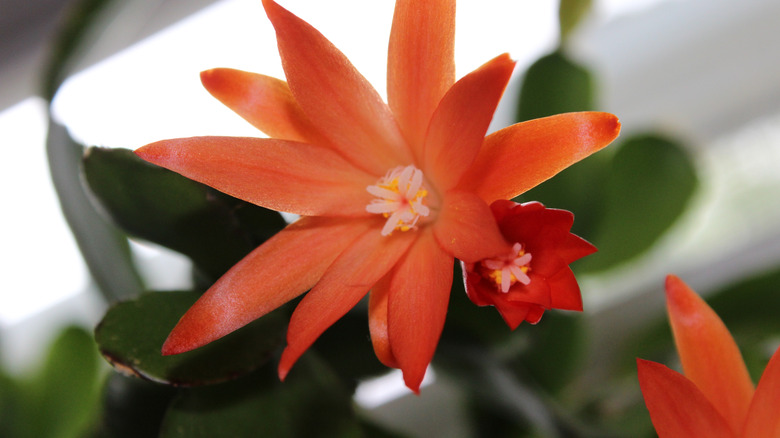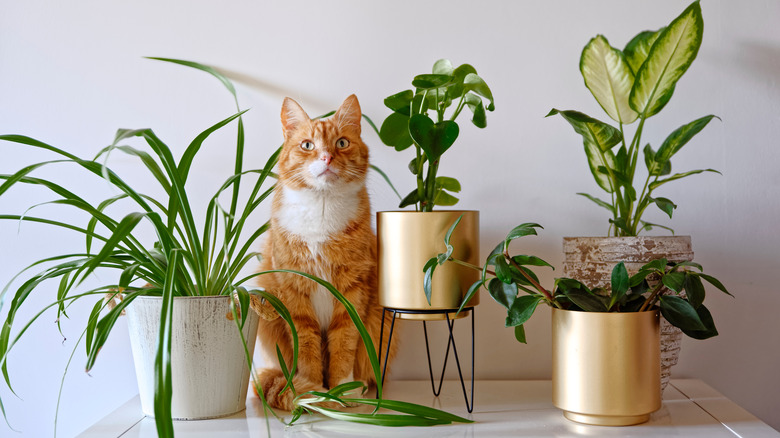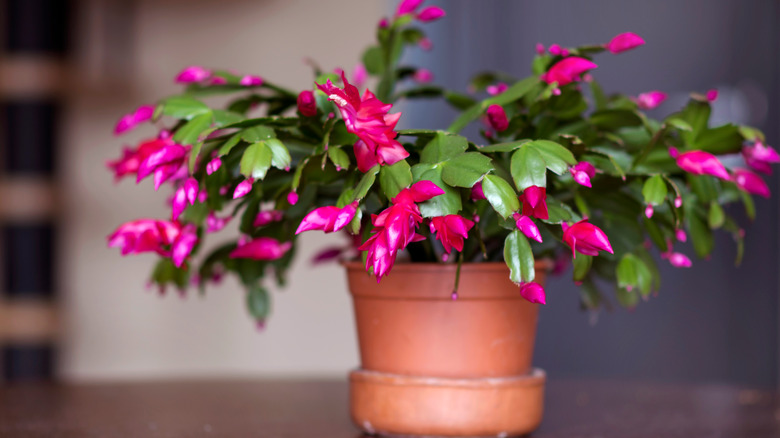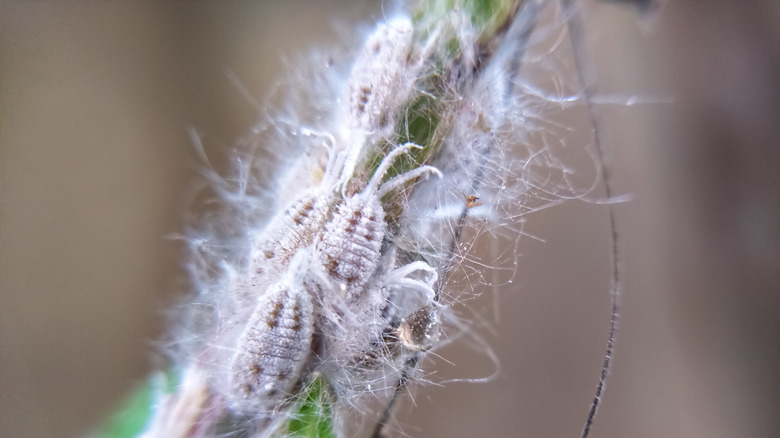How To Care For An Easter Cactus
Native to Brazil's rainforest, the Easter cactus (Schlumbergera gaertneri, formerly Hatiora gaertneri) is vastly different from its desert counterparts. Accustomed to cooler temperatures and higher humidity, this species of succulent shares little in common with desert plants. Easter cacti have flat, jointed stems made up of 2 to 3 inch segments. Their bright flowers look like colorful cones, made up of about a dozen curled petals that come in a variety of colors, such as red, orange, and pink (per UA Division of Agriculture).
Easter cacti are often mistaken for Thanksgiving and Christmas cacti due to their similar shape and foliage. Though they are related and all named for the season in which they bloom, they belong to different plant species. According to NC State Extension Gardener, you can tell the species apart by the shape of their stem segments — the Easter cactus has the most rounded shape. The Easter cactus is also less commonly found than the more popular Christmas or Thanksgiving cacti, likely due to it's more temperamental nature. Nevertheless, these plants still make great houseplants when given the correct care. If you're looking for an unusual plant, or a way to bring some springtime color into your home, look no further, because the Easter cactus just may be the plant for you.
How to grow an easter cactus
Easter cacti can be grown from seeds found in the small fruits they produce. The Rainforest Garden says to start by carefully opening a ripened fruit, which will contain dozens of tiny seeds. Next, spread the seeds out on a paper towel and do your best to remove any remaining pulp. Once the seeds are clean, move them to a fresh paper towel and prepare a shallow tray with potting soil. Place the paper towel with the seeds atop the soil, and water thoroughly. As the seeds begin to germinate, separate them into larger, individual pots so they can continue growing freely.
Propagating your Easter cactus can be simply done with a clipping of your plant. Our House Plants suggests clipping your cactus during the summer months to avoid damage to your plant. For the clipping, find a healthy stem, and clip off a piece two to three segments long. Wait a couple days while the clipping dries, and then stick the lower portion about 1 inch deep into a pot of composted soil. Only keep the clipping slightly moist as the roots begin to develop, because they are prone to rotting if exposed to too much moisture.
How to care for an easter cactus
Luckily, caring for an Easter cactus is not a particularly difficult task. Unlike traditional desert cacti that thrive in hot, dry, open environments, the Easter cactus is native to the much-wetter Brazilian rainforest. Easter cacti have a low tolerance for heat, preferring cooler temperatures both day and night. Gardening Know How also cites their preference for bright light. The sunlight they receive in their native environment, however, is filtered through the tree canopy; therefore, set your Easter cactus by a bright window but avoid placing them directly in the sunlight.
Easter cactus enjoy relatively moist, well-draining soil. The soil you provide should be a loose, container-specific mixture, in order to accommodate the plant's root growth and maintain sufficient air flow. Adding extra nutrition to the soil, such as compost or fertilizer, can encourage growth and good health. Allow the soil to dry out between waterings, but water the plant thoroughly when you do so (per The Spruce). The most important factor is adequate drainage, so the plant stays moist but doesn't sit in waterlogged soil.
Easter cacti bloom around the Easter holiday for which they are named, around late winter to early spring. To encourage vigorous blossoms, cease fertilization, decrease watering, and place them in a cooler, darker area in the late fall, a few months prior to their scheduled bloom. Place them in warmer area at the start of the blooming season, and enjoy the beauty of their colorful flowers.
Easter cactus varieties
The original Easter cactus (Schlumbergera gaertneri, also known as Rhipsalidopsis gaertneri) is well-loved for the reddish-pink flowers it produces. As the Easter cactus grew more popular in households around the world, several hybrids of this species were developed, bringing new colors and shapes to the already beloved houseplant (per Logee's). Here are a few varieties that were created:
-
Easter cactus 'Scorpius' (Rhipsalidopsis gaertneri): This variety is known for its beautiful bright, red flowers that can be enjoyed during its two to three month-long blooming season.
-
Orange Easter cactus 'Colomba' (Rhipsalidopsis gaertneri): Resembling the beauty of a gorgeous sunrise, this Easter cactus produces vibrant orange blossoms that only open when the sun is out.
-
White Easter cactus 'Sirius' (Rhipsalidopsis hybrid): Unlike the vibrantly-colored blossoms most Easter cacti have, this Easter cactus variety has elegant white flowers that resemble bright stars.
-
Dwarf Easter cactus (Rhipsalidopsis rosea): This dwarf variety is a smaller version of the original Easter cactus, producing small, pale pink flowers (per The Garden Helper).
Is easter cactus toxic?
There are many desert cacti species that are known for having edible parts. For example, the nopales of the versatile Prickly Pear cactus can be cooked, or simply enjoyed as-is. Their sweet extract can also be used to flavor anything from beverages to pastries and desserts. The Barrel cactus grows tart yellow fruit that can also be cooked or eaten raw, and their protein-rich seeds can be crushed into a coarse flour, according to Experience Scottsdale. The Easter cactus, however, is different from desert cactus in this regard as well, as it is not considered edible and cannot be comfortably eaten by humans.
The Easter cactus is made of very fibrous materials that, when eaten, can cause symptoms that range from mild discomfort to more serious vomiting and diarrhea. The plant does produce fruit, but only wild birds and other animals can tolerate safe consumption (per The Knowledge Burrow). Regarding animals commonly kept as pets, Houseplant Central mentions that ingesting parts of the plant may cause discomfort in cats and dogs, but the Easter cactus is non-toxic and does not pose any risk of serious health effects or lasting harm.
How to repot an easter cactus
The Easter cactus is typically grown indoors and will thrive in its planter, especially if it is routinely given fresh soil. Gardening Know How recommends repotting an Easter cactus every two years, in the early spring before it blooms. If it show signs of outgrowing its current pot, you can find them a new one that is the next size up. If it seems content in their current pot, you can simply change our their soil and place it back inside.
Before lifting the Easter cactus out of its current pot, the Desert Plants of Avalon Youtube video recommends using a long-ended spoon to loosen the root ball of the plant. To do this, stick the flat end of the spoon into the soil just against the edge of the pot. Move the spoon around the circumference, and then tilt the pot and gently slide the plant out. Use compost to line the bottom of the container, and then place the plant inside, centering it in the pot. Fill any remaining space with potting soil. Unlike most other plants, you should avoid watering your Easter cactus for a few days to allow the roots to recover from the transplant, but then continue caring for your plant as normal.
Common problems with easter cactus
Because Easter cacti are most commonly used as household plants and enjoy living in a potted environment, they don't face the same pest problems that regularly plague outdoor plants. They are, however, still at risk of harm from pests that infiltrate and afflict plants within a home, such as mealybugs, scale, and fungus gnats (per The Spruce). Thankfully, Plant Perfect recommends several steps you can take to prevent these unwanted pests from attacking any of your houseplants.
As a first step, closely examine new plants before introducing them to your household, and keep them separate from any other plants you already have to avoid the spread of any unseen pests or diseases. Once the new plant has been quarantined long enough to confirm its health status, you can let it mingle with your existing plants. Make sure that each of your plants has enough space for proper air circulation, and try to avoid overwatering the soil. The latter precaution is also key to avoid root rot from developing. Most importantly, try your best to keep your plants in good health. Healthy and strong plants have the ability to ward off unwanted pests; therefore, provide your plants with plenty of light, fertilize them during their growing season, and ensure they have the right accommodations based on their species.
